Labrador Duck: Not extinct after all?
Dead duck? Or science amok?
EUGENE M. MCCARTHY, PHD GENETICS
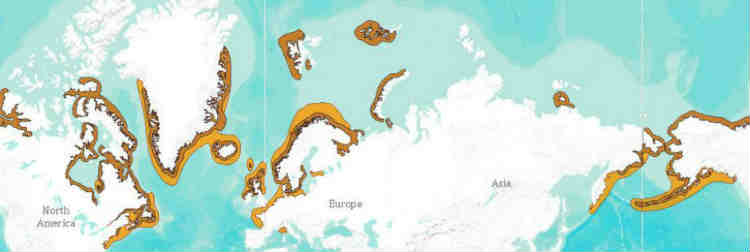 Range of the Common Eider. Brown: breeding; Orange: non-breeding.
Range of the Common Eider. Brown: breeding; Orange: non-breeding.
|
Let us trust to ourselves, see everything through our own eyes; for they are our tripods, our oracles, and our gods.
— Voltaire, Oedipe
|
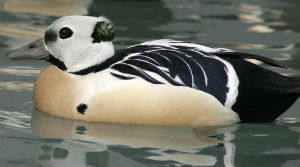 Steller’s Eider
Steller’s EiderPolysticta stelleri
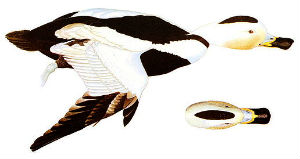 Labrador Duck
Labrador DuckCamptorhynchus labradorius
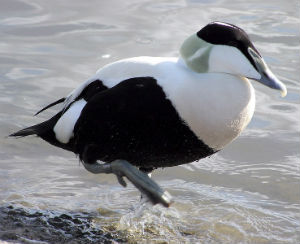 Common Eider
Common EiderSomateria mollissima
Treated as a species and described from specimens last collected in the 1870s, the Labrador Duck (Camptorhynchus labradorius) is supposedly extinct. Thus waterfowl expert John C. Phillips (1922, vol. 1, p. 34) commented that, “During the ornithological history of this country only one species of North American duck has disappeared, namely, the Labrador Duck.”
Labrador Duck is a synonym of Pied Duck, the vernacular name used by early writers such as John James Audubon, who in his famous Birds of America (1840-1844) listed it under the binomial Fuligula labradora.¹
But in fact, it seems that descriptions of this “species” were based on specimens of what were probably natural hybrids of Steller’s Eider (Polysticta stelleri) and Common Eider (Somateria mollissima). Indeed, the obvious eiderlike character of these ducks is reflected in the French name for C. labradorius, “Eider du Labrador.” Like eiders, they were sea ducks that fed on small shellfish, most commonly mussels, and their flesh is said to have had the bad, fishy, sea-duck flavor of eider. Its bill, too, in having a wide, flattened tip with numerous interior lamellae, was very similar to that of a Steller’s Eider, but quite different from those of other ducks. Indeed, in a phylogeny based on 120 separate morphological characters (Livezey 1986) Camptorhynchus grouped closely with Polysticta and Somateria.
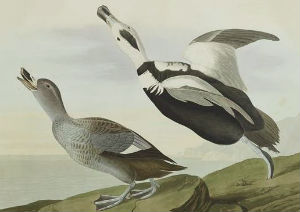 Audubon’s painting of a pied duck pair (based on two birds shot on the coast of Massachusetts by Daniel Webster). Pied Duck is a synonym of Labrador Duck.
Audubon’s painting of a pied duck pair (based on two birds shot on the coast of Massachusetts by Daniel Webster). Pied Duck is a synonym of Labrador Duck.
Labrador Duck: Habitat unknown
Sibley and Monroe (Distribution and Taxonomy of Birds of the World, 1990, p. 40) state that the characteristic habitat of C. labradorius is unknown, and that it was last recorded in 1878 (USNM specimen number 77126). They also note that it was “alleged to have bred in Labrador” and was recorded from Nova Scotia and New Brunswick south to New Jersey, and inland to Quebec. It’s not surprising that they use the word alleged since “knowledge” of these ducks breeding in Labrador — or anywhere else for that matter — apparently derives solely from the third-hand information given in the following passage in Audubon (from his section on the Pied Duck):
Eggs provide no clue to the locale of the Labrador Duck’s breeding ground. In a genetic study, Chilton and Sorenson (2007) showed that all eggs formerly assigned to this bird were actually misclassified. So no eggs from Camptorhynchus are known.
Such is the gossamer basis — other than an early mention of two birds sent to Sir Joseph Banks from Labrador (Wilson and Bonaparte 1831, p. 218) — for naming this duck Labrador. As William Dutcher later wrote (quoted in Rothschild 1907, p. 105),
|
|
|
Ornithologist William Dutcher (1846-1920) |
Moreover, it’s well known that hybrids have often been formally described as species. For example, Audubon treated Mallard-Gadwall hybrids as a species, “Brewer’s Duck” (Anas breweri), and hybrids of yellow-shafted and red shafted flickers as “Ayres’ Flicker” (Colaptes ayresi); two other rare birds Audubon described as species, Dendroica carbonata and Emberiza townsendii, probably fall into the same bucket (McCarthy 2006). Likewise, for more than fifty years, American ornithologists treated as species (Vermivora lawrencei and V. leucobronchialis) two different types of birds derived from hybridization between the golden- and blue-winged warblers (Vermivora chrysoptera and V. pinus). Many other such examples are given in McCarthy (2006).
|
Synonyms (Source: http://worldbirdinfo.net) |
|
Anas labradoria J. F. Gmelin, 1789 Anas labradora Latham, 1790 Rhynchaspis labradora Stephens, 1824 Fuligula labradora Bonaparte, 1826 Somateria labradora Boie, 1828 Kamptorhynchus labradorus Eyton, 1838 Camptorhynchus labradorus Bonaparte, 1838 Camptolaimus labradorus G. R. Gray,1841 Camptolaemus labradorus Lichtenstein, 1854 Camptolaemus labradorius Baird, 1858 Anas labradorica Hall, 1862 Fuligula labradoria Seebohm, 1885 Camptolaemus labradoricus P. L. Sclater,1880 Camptolaimus labradorius Stejneger, 1883 |
|
Female Labrador Ducks
Female Labrador ducks raise a separate issue. They do not resemble eiders. So what do they mean for this theory? Well, one obvious possibility is that they may represent some hybrid of another type and have only been mistakenly identified as female Labradors. This sort of thing happens fairly often with rare hybrids. After all, without genetic testing, how can anyone really know that these males and females are both the same kind bird? No one ever saw them nesting together (or even during breeding season). To date it seems no such tests have been carried out. Another thing that occurs in a wide variety of avian hybrid crosses is for all, or nearly all of the hybrids to be male (McCarthy 2006). Such is the case, for example, in such crosses as pigeon × turtle dove or canary × twite or chicken × common peafowl (ibid.). If the same holds for the cross currently under consideration then male “Labrador Duck” specimens would represent a monosexual, probably sterile, hybrid (monosexual avian hybrids tend to be quite sterile). There would be no females, which would explain why not a single Labrador Duck egg is known. |
Flannery and Schouten (2001, p. 60) comment that “For a species whose winter range included a well-populated region, remarkably little is known about it. This may be due to the fact that it was always apparently rather rare.” He goes on to say (p. 61) that only 31 museum specimens are known (Chilton and Sorenson, 2007, state that there are 55). Even Audubon, writing in the early 1840s when most North American birds were far more plentiful than today, described it as rare. And at a yet earlier date, ornithologist Charles Lucian Bonaparte (1826) described it as “a very rare and beautiful species.” Another famous expert on American birds, Alexander Wilson (Wilson 1832, vol. 3, p. 114) noted that “This is rather a scarce species on our coasts, and is never met with on fresh water lakes or rivers.” Between 1840 and 1860, according to Dutcher (1891, pp. 201-202),
The very rarity of the specimens is suggestive of the idea that they are hybrids, as is the high level of plumage variation apparent in Google images of various specimens held in museums. High levels of variability are especially characteristic of hybrids. Moreover, the plumage and bill coloration of these ducks combine the patterns seen separately in Steller’s eiders and common eiders, two birds that are reported to produce natural hybrids (McCarthy 2006). Specimens assigned to C. labradorius have a black back and neck ring, as in Steller’s, but a black crown and belly as in common eiders (see pictures on this page).
Steller’s eiders and common eiders come into contact and interbreed along the shores of the Arctic Ocean (McCarthy 2006). Their hybrids are not common, but are, in fact, occasionally seen. (See the separate section below titled “Geographic Issues” for a more detailed discussion of present and past regions of breeding contact between these two eiders.)
So maybe we’ve been mourning without reason the demise of “a very rare and beautiful species.” Perhaps Camptorhynchus labradorius is just another instance among hundreds of cases in which birds once treated as species turned out to be hybrids.
This entire article has been speculation, of course, and does not prove anything. But given the points covered here, the status of the Labrador Duck does seem rather doubtful. Fortunately, it will be quite easy to resolve this question by making genetic comparisons between museum specimens and the putative parents. If these specimens are hybrids, they would, presumably, be F₁ hybrids, which would make the analysis fairly straightforward (for more information in this connection, see the discussion titled “Genetic Issues” below).
It would certainly be nice to cross even one name off the extinction list!
Another “extinct species” that’s a likely hybrid >>
About another rare duck hybrid >>
It has been objected that the regions where hybridization can potentially occur between Steller’s and common eiders are implausibly distant from the northeastern U.S. where most Labrador Ducks were collected. Indeed, these birds come into regular contact during breeding season only in Alaska and eastern Russia, and along the southern coasts of the Kara and Barent’s seas (compare map in Nygard et al. 1995 pdf with the map at the top of this page; see also Atlas of European Breeding Birds and Pearce et al. 2005), and both these regions are far distant from New England. However, the breeding range of the Common Eider is circumpolar (see map at top of this page). So potential hybridization with vagrant individual Steller’s might well occur almost anywhere in the Arctic region. Vagrants often end up producing hybrids because they cannot find mates of their own kind (McCarthy 2006). For example, off the Northumberland coast in the U.K. (Farne Islands), a Lesser Crested Tern (Sterna bengalensis) returned for 14 years to the same sandwich tern colony, producing hybrid offspring (ibid.). There is really no way to know exactly how many Steller’s vagrants were reaching North America back in the 19th century, but Steller’s populations were much larger then and, perhaps, geographically more extensive. In the 18th century when Steller first discovered it, this duck bred on the Kamchatka Peninsula far south of anywhere it breeds today. However, it is known that vagrant Steller’s Eiders reach the Atlantic coast of North America even today. Thus, Toochin and Haviland (2013) state that “In Eastern North America, Steller’s Eiders have been found in the Canadian Eastern Arctic, Quebec, Maine, Massachusetts and Greenland” If these individuals paired up with resident common eiders, say in northern Labrador, then their hybrids would have flown south to the northeastern U.S. during winter, and with the larger parental populations in existence at that time, hybrids might well have been more common. Annually, it would not take many such vagrant hybridizations to produce the 55 specimens of Labrador Duck collected during the century between its first description and supposed demise. In some hybrid crosses, because the parents have little propensity to mate, virtually no hybrids occur except when a vagrant is forced to find a mate other than its own kind, which is perhaps the reason why hybrids of this type would be produced primarily in the eastern Arctic of North America where, of all Arctic coast regions, Steller’s densities are lowest.
Chilton and Sorenson (2007) isolated two short (72 nt and 137 nt) mitochondrial DNA (mtDNA) sequences from a stuffed Labrador Duck (the DNA was taken from a single feather). In their paper they state (p. 965b) that “The ND2 and 12s sequences we obtained from the Labrador Duck museum skin were similar to but uniquely different from those of all other sea ducks (M. D. Sorenson et al. unpubl. data).” The GenBank accession numbers for these two sequences are DQ831199 and DQ831207, respectively.
However, these two sequences have not, in fact, been reported for “all other sea ducks.” In particular, no ND2 and 12s sequences have been reported for Polysticta stelleri. At least, no such sequences are in GenBank as of 2/24/2014. So it might well be, though we have no way of knowing given the present state of knowledge, that Chilton and Sorenson’s sequences would perfectly match P. stelleri (which would strongly indicate that their specimen was a hybrid). Due to its much smaller relative size, P. stelleri is the probable female parent in this cross, and would thus be the likely source of mtDNA in any hybrid.
Blast searches against the genus Somateria show that the two sequences characterized by Chilton and Sorenson differ from Somateria by 6% (12s) and 4% (ND2), respectively. So it’s interesting that blasts using a different mitochondrial gene, cytB (529 nt) from P. stelleri (GenBank accession # AY351685) as query show that Somateria differs from P. stelleri by about 8%. (Since the size of these differences is approximately comparable, Chilton and Sorenson’s “Labrador Duck” sequences might in fact be P. stelleri sequences.)
Another issue is Chilton and Sorenson’s use of the term “uniquely different,” which is a non-quantitative description. To reject the hypothesis that Camptorhynchus represents a Steller’s × Common Eider hybrid, one would need to have not only sequence data for P. stelleri to compare with the two sequences known for Camptorhynchus, but also some kind of measure for mtDNA variability both for Steller’s and the Common Eider. One could then use that measure to establish a confidence interval for the expected range of variation for both. Chilton and Sorenson’s sample would have to fall well outside of both those intervals (strong p value) for the hypothesis to be rejected.
Another problem is that Chilton and Sorenson took their Labrador Duck sample from a single feather. From the standpoint of reliability, it would have been preferable to obtain sequences from other Labrador Duck specimens to confirm their sequences. That is, for the method they used, polymerase chain reaction (PCR) to be reliable, multiple sequences must (1) be generated with separate amplifications; and (2) cross checked with each other to eliminate phantom sequences resulting from contamination (which is a very common problem with PCR). Given the rarity of museum specimens, it’s understandable that they chose not to do this, but without such cross comparison, such data seems unreliable.
So what’s needed to resolve this question is to obtain and compare reliable mtDNA sequences for all three birds, that is, the posited hybrids and each of the two posited parents, particularly P. stelleri.
Works Cited:
Flannery, T., Schouten, P. 2001. A Gap in Nature. New York: Atlantic Monthly Press.
McCarthy, E. 2006. Handbook of Avian Hybrids of the World. New York: Oxford University Press.
Phillips, J. C. 1922. A Natural History of Ducks. Boston: Houghton-Mifflin, volume 1.
Rothschild, W. 1907. Extinct Birds. London: Hutchinson and Co.
Wilson, A. 1832. American Ornithology, vol. 3. London: Whittaker, Treacher and Arnott.
Note:
1. This duck was first described, under the name of Pied Duck, in 1785 by Thomas Pennant (Arctic Zoology II, p. 559) as follows:
Labrador Duck - © Macroevolution.net
McCarthy, E. M. 2014. Labrador Duck: Not extinct after all? www.macroevolution.net/labrador-duck.html (Add access date).
By the same author: Handbook of Avian Hybrids of the World, Oxford University Press (2006).
Another picture of a Labrador Duck >>
© Macroevolution.net
Most shared on Macroevolution.net:
Human Origins: Are we hybrids?
On the Origins of New Forms of Life
Mammalian Hybrids
Cat-rabbit Hybrids: Fact or fiction?
Famous Biologists
Dog-cow Hybrids
Georges Cuvier: A Biography
Prothero: A Rebuttal
Branches of Biology
Dog-fox Hybrids